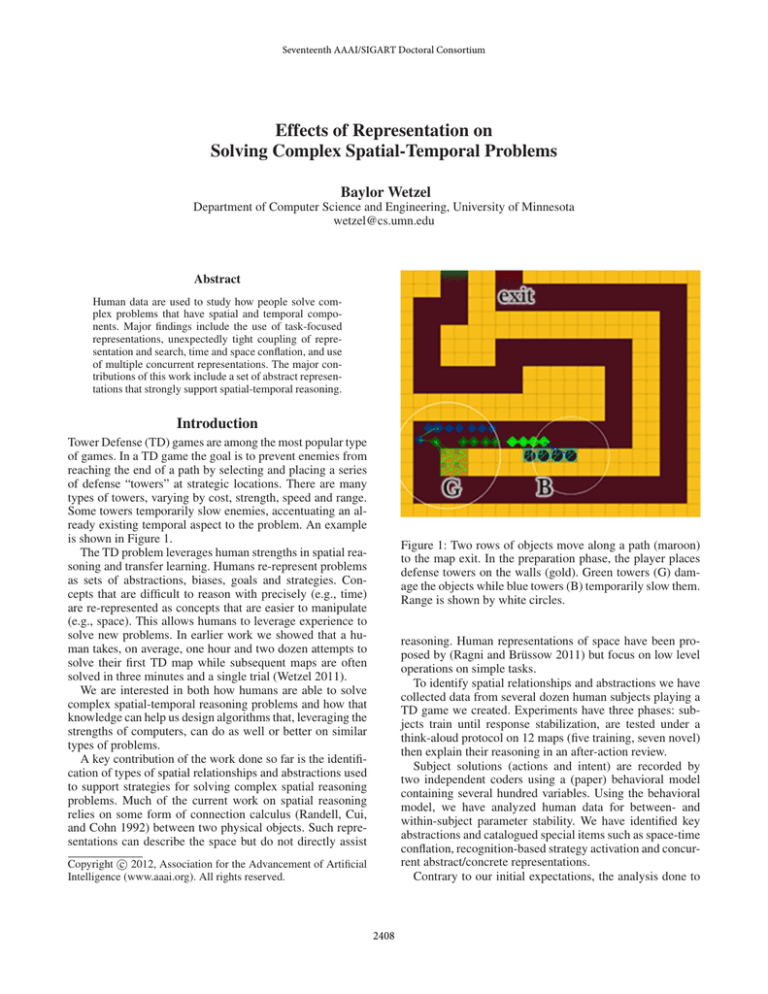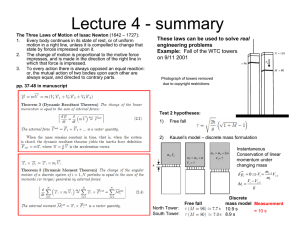
Seventeenth AAAI/SIGART Doctoral Consortium
Effects of Representation on
Solving Complex Spatial-Temporal Problems
Baylor Wetzel
Department of Computer Science and Engineering, University of Minnesota
wetzel@cs.umn.edu
Abstract
Human data are used to study how people solve complex problems that have spatial and temporal components. Major findings include the use of task-focused
representations, unexpectedly tight coupling of representation and search, time and space conflation, and use
of multiple concurrent representations. The major contributions of this work include a set of abstract representations that strongly support spatial-temporal reasoning.
Introduction
Tower Defense (TD) games are among the most popular type
of games. In a TD game the goal is to prevent enemies from
reaching the end of a path by selecting and placing a series
of defense “towers” at strategic locations. There are many
types of towers, varying by cost, strength, speed and range.
Some towers temporarily slow enemies, accentuating an already existing temporal aspect to the problem. An example
is shown in Figure 1.
The TD problem leverages human strengths in spatial reasoning and transfer learning. Humans re-represent problems
as sets of abstractions, biases, goals and strategies. Concepts that are difficult to reason with precisely (e.g., time)
are re-represented as concepts that are easier to manipulate
(e.g., space). This allows humans to leverage experience to
solve new problems. In earlier work we showed that a human takes, on average, one hour and two dozen attempts to
solve their first TD map while subsequent maps are often
solved in three minutes and a single trial (Wetzel 2011).
We are interested in both how humans are able to solve
complex spatial-temporal reasoning problems and how that
knowledge can help us design algorithms that, leveraging the
strengths of computers, can do as well or better on similar
types of problems.
A key contribution of the work done so far is the identification of types of spatial relationships and abstractions used
to support strategies for solving complex spatial reasoning
problems. Much of the current work on spatial reasoning
relies on some form of connection calculus (Randell, Cui,
and Cohn 1992) between two physical objects. Such representations can describe the space but do not directly assist
Figure 1: Two rows of objects move along a path (maroon)
to the map exit. In the preparation phase, the player places
defense towers on the walls (gold). Green towers (G) damage the objects while blue towers (B) temporarily slow them.
Range is shown by white circles.
reasoning. Human representations of space have been proposed by (Ragni and Brüssow 2011) but focus on low level
operations on simple tasks.
To identify spatial relationships and abstractions we have
collected data from several dozen human subjects playing a
TD game we created. Experiments have three phases: subjects train until response stabilization, are tested under a
think-aloud protocol on 12 maps (five training, seven novel)
then explain their reasoning in an after-action review.
Subject solutions (actions and intent) are recorded by
two independent coders using a (paper) behavioral model
containing several hundred variables. Using the behavioral
model, we have analyzed human data for between- and
within-subject parameter stability. We have identified key
abstractions and catalogued special items such as space-time
conflation, recognition-based strategy activation and concurrent abstract/concrete representations.
Contrary to our initial expectations, the analysis done to
c 2012, Association for the Advancement of Artificial
Copyright Intelligence (www.aaai.org). All rights reserved.
2408
date suggests that the key to spatial-temporal reasoning is
not a complex reasoning process but a series of learned goalselection biases paired to task-focused, context-dependent
data representations. Our work shows that spatial representations are abstract (to support transfer learning) but tightly
coupled to the reasoning process. We also show that humans
use affordances, i.e. qualities of objects that enable or suggest actions.
Figure 2: The strategy Maximum Usable Range (left) attempts to maximize time by maximizing space. The strategy Temporal Separation of Attack Windows (right) sacrifices space to increase time.
Initial Results
In the tower placement process, human subjects choose a relationship between the object to be placed (target) and a reference object (anchor). Although the target and anchor can
be any object or spatial feature (e.g., tower, U-turn), they are
more commonly items such as an object’s properties (e.g.,
a tower’s range, a tower’s range’s exit boundary), effects
(e.g. the space over or duration which an object is slowed)
and spatial affordances (e.g., a spot where the path passes
through a specified tower’s range three times).
Much of the “reasoning” work we observed is actually
handled by the representation. Consider a subject whose
play style is to create a single large offensive area and line
the path leading to it with slowing towers and light attack
towers. For the placement decision of the light attack towers, the target is a chain of locations and the anchor is, first,
a spatial gap between a path entrance and a neighborhood
and, second, a compromise between usable range and an active effect (i.e., the enemies are slowed). Representing the
map as a set of strategically valuable features such as spatial
gaps, role-based groups, effect areas, or path splits, makes it
easier to represent, transfer and instantiate strategies.
TD has some interesting properties that are not immediately apparent and have not been addressed in other literature. One of these is the relationship between space and
time. Dedicated visual processing centers make many spatial
tasks easy and effortless for humans. One such task is judging the relative size of two areas. A common TD strategy is
maximum usable range – place towers where they cover the
largest number of path cells. The assumption is that the more
area the tower covers, the more damage it can do. This strategy relies on a spatial property while a tower’s total damage
dealt relies on a temporal property – the total damage is the
product of the damage done in one time unit by the time
the tower is active. Since the unit damage is constant, the
goal should be to find places that maximize the active time.
Many subjects reasoned that a larger range meant the tower
was active for more time and therefore area was a useful approximation of tower temporal activity. Substituting spatial
properties for temporal ones allowed subjects to leverage innate spatial abilities, allowing subjects to quickly generate
good solutions to moderately difficult TD problems.
While time and space can be profitably conflated, the risk
is missing superior strategies. In Figure 2, the towers on the
left cover 30 path cells. Observant players noticed that the
first enemy could be attacked over the entire range but, as
long as the tower was focused on the first enemy, subsequent
enemies could move through the range unharmed. The result
is that the amount of time the tower has to attack an enemy
shrinks over time.
Subjects solved this queuing problem with a strategy we
called temporal separation of attack windows. In Figure 2,
the towers on the right have two independent attack windows
(top and bottom). The first enemies leave the range early,
allowing the towers to focus on later enemies, and do not reenter the range until the towers have finished with the later
enemies. Neither group is able to provide a significant buffer
for the other. Although the towers on the right cover 13%
less area (26 path cells), they fire 30% more often (546 vs.
711 times), resulting in a score 73% higher (11 vs. 19).
Future Work
We have created a random baseline agent, implemented
some of the identified spatial-temporal features in agents
that use those features to decide where to place the defense
towers. We currently are interestied in determining the effectiveness of the strategies and testing the agents’ performance on the maps we used with human subjects. To support
our implementation we are working on a Spatial Affordance
Query System, which allows an agent to perform the types
of queries identified in our human subject studies against an
annotated map that is auto-generated from the map geometry.
In the longer term, we hope to follow up on our initial
findings regarding how human subjects revise their strategies in the face of feedback, how they transfer knowledge
across maps and on the mechanisms of negative transfer.
References
Ragni, M., and Brüssow, S. 2011. Human spatial relational
reasoning: Processing demands, representations, and cognitive model. In Proc. Nat’l Conf. on Artificial Intelligence
(AAAI).
Randell, D. A.; Cui, Z.; and Cohn, A. G. 1992. A spatial
logic based on regions and connection. In Proc. Int’l Conf.
on Knowledge Representation and Reasoning.
Wetzel, B. 2011. Transfer learning in spatial reasoning
puzzles. In Int’l Joint Conf. on Artifical Intelligence, 2864–
2865.
2409




